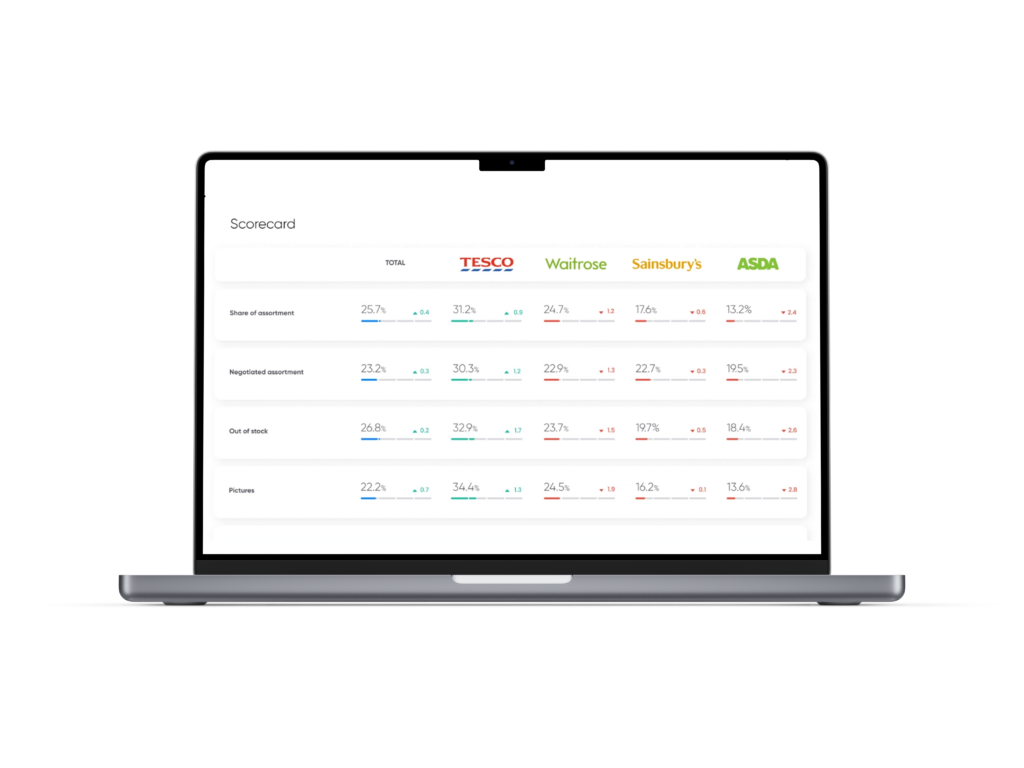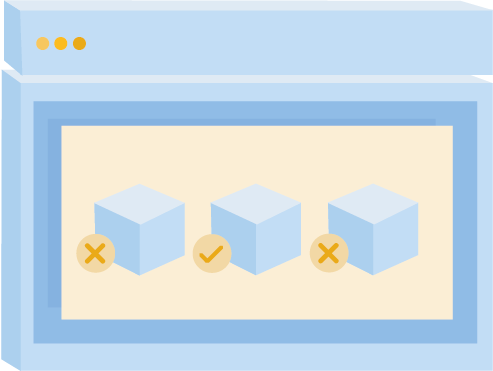The key features of digital shelf analytics
Digital shelf performance is analyzed through key KPIs, such as out of stock.
Out of stock (OOS) is foundational because other performance indicators depend on it. If a product isn’t present on the digital shelf it can’t appear in search, any media activations associated with it will be ineffective, and it can’t be sold. Other KPIs that make up the typical suite of digital shelf software are price and promotion, negotiated assortment, share of assortment, distribution, share of voice, image compliance and product title description.

“The objective of digital shelf software is to understand your brand’s performance on the shelf so that you can improve it.”
-Yacine Terki, CEO, Data Impact by NielsenIQ
The necessity of digital shelf software

There are 2 major reasons why CPG digital analytics are essential.
First, their use is already widespread, so to stay competitive they are a must. For instance, if a product starts to lag in search rankings, it’s crucial to know why competitors are pulling ahead. Digital software will alert you to a drop in search averages. Good software will also provide guidance for making changes that will help to regain lost positions. For instance, are product titles and descriptions perfectly aligned with target keywords? Or take ratings. If ratings are slipping the software can help identify patterns in negative reviews. The issue could be a product quality, a consumer trend or some aspect of the service you’re offering.
Digital shelf analytics will alert you when a product is OOS, allowing you to address any supply chain issues or adjusting media spends you may have for that product, thus saving advertising investments.
Second, without a software suite, or a solution provider partner that provides customized digital solutions for your business, it’s basically impossible to stay on top of all the relevant data manually on your own.
With omnichannel activity increasing, a common remark from manufacturers is that they spend an inordinate amount of time cleaning and sorting through data. Some of this data can be collected manually, but the uptake of egrocery is making this proposition untenable for ecommerce managers.
With (potentially) thousands of SKUs and thousands of online stores, keeping up with all the data just isn’t feasible.
Digital shelf management

Digital shelf software uses data analytics that allows you to not only track, but manage your digital shelf with a minimum of effort. Since the digital shelf is constantly changing, this process is ongoing. New products are introduced, promotions are offered, prices get changed, products get updated and user-generated content is added.
A well-managed digital shelf ensures that your product is being discovered and sold, with the corresponding product description page (PDP) being updated and optimized when necessary-including names, images, description, prices, promotions and more. Location-based data collection is important to ensure that a product’s performance on the digital shelf is being optimized. Sample-based data collection will capture very few of a product’s performance indicators.
Evaluating share of search and search position

Search performance holds particular interest for ecommerce managers. Their common pain points are not knowing how to optimize a product’s visibility per retailer, and not being aware of search results varying from online store to store.
Digital shelf software gives ecomm managers the ability to optimize product pages to correlate to the differing search algorithms of each retailer.
Good digital shelf analytics also give ecommerce managers a true measurement of search performance when those analytics measure search results at every online store as opposed to just a sample of stores. A sample will render results non-representative of the whole.
Product information management (PIM)
Also useful to ecomm managers, PIM software offers a simplified way to ensure product images and associated content is correctly displayed. A content tracking feature continually monitors the information in the product pages and signals where they need to be updated, per retailer.
This software can not only monitor but improve the performance of product pages.
Out of stock tracking per store

This KPI is of particular importance to key account managers (KAMs). Tracking OOS, distribution by store, blockbuster distribution, and online vs. in-store distribution gives KAMs a comprehensive view of assortment and distribution. This tracking answers the pain point of an incorrect view of distribution. A common reason for a misrepresentation of OOS is using a sample of stores to generate the measurement.
Tracking OOS is also useful from a competitive standpoint. When competitors go out of stock, it can be an ideal time to buy paid search on their branded keywords.
Similarly, if your own products go out of stock nationwide, it could be beneficial to adjust any ad spends associated with that product. It’s pointless and expensive to pay to direct customers to a product that they can’t buy.
Pricing
Minimum Advertised Pricing (or iMAP for Internet MAP) violations can also be monitored by digital shelf software. This is of particular interest to category managers. It offers an instant snapshot of all the stores a product is being listed at a price point lower than the iMAP–if the software employs comprehensive, store-level data analysis.
Ratings and reviews

The category trends that ratings and reviews can reveal are useful to category managers.
Often their understanding of online category movements and assortment changes is limited by an analysis of a sample of stores. Again, an analysis that encompasses all stores can yield powerful insights into competitor strategies, customer trends and product development.
Customizable digital shelf scorecard with alerts
A scorecard is an immediate way for CPGs to see how their products are performing online. It provides instant insight into what aspects of the digital shelf need attention. The sub-optimal aspects of the digital universe that customers encounter when they explore online will be signalled, allowing manufacturers to constantly fine-tune their digital assets to strengthen their position on the shelf.
A customizable scorecard, such as the one Data Impact by NielsenIQ offers, makes the scorecard even more efficient and precise by providing only the information the user needs and chooses.
In conclusion, it’s critical to ensure that data offered by digital shelf software is actionable. A lot of data is available from many different sources today, but if it doesn’t provide clear guidance, and a predictive analysis of the results it will bring, its usefulness will be greatly diminished.